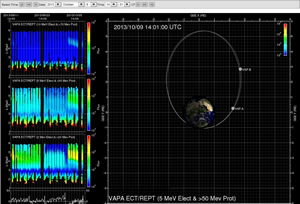October 9, 2013
In The Loop: Van Allen Probes Provide Way to “Watch” Juno Fly-by
At 3:21 pm EDT on Wednesday, Oct. 9, 2013, NASA’s Juno spacecraft will pass over South Africa – a mere 350 miles above our planet – as it makes a gravity-assisted “slingshot” to speed it to Jupiter, where it will arrive in 2016. Juno, which launched in August 2011, will be traveling some 87,000 miles per hour when the slingshot is complete.
Even though Juno won’t be visible in the western hemisphere, the Van Allen Probes team at the Johns Hopkins University Applied Physics Laboratory (APL) in Laurel, Md. has put together a way to “watch” the fly-by. APL has created a near real-time space weather monitoring visualization that will let the public view Juno’s passage around the Earth, along with plots of the locations of NASA’s Van Allen Probes and data from their space weather beacons. The plots will show the high-energy electrons and protons that populate the Earth’s outer Van Allen radiation belt. Follow Juno’s fly-by and the Van Allen Probes on this visualization here: http://athena.jhuapl.edu/juno/
“You’re going to see the real-time space weather data from the Van Allen Probes, showing the conditions around the Earth as Juno flies past,” says APL’s Rob Barnes, Van Allen Probes science operations center coordinator. “The visualization will update every minute, while the space weather data updates every 15 minutes. Later, we’ll be able to provide more detailed ground analysis combining data from the probes and from some of Juno’s instruments which measure similar ranges of energy.” Juno should become visible in the main tracking visualization around 2 p.m. EDT on Oct. 9.
Much like the Van Allen Probes, Juno is interested in particles – in this case, those around the solar system’s largest planet. One of the many instruments on board Juno is the Jupiter Energetic Particle Detector Instrument (JEDI), which was built by APL, and JEDI’s investigation is led by APL’s Barry Mauk, project scientist for the Van Allen Probes. The Radiation Belt Storm Probes Ion Composition Experiment (RBSPICE) instruments on the Van Allen Probes are, in many ways, very similar to JEDI.
-Geoff Brown
The Van Allen Probes are the second mission in NASA's Living With a Star Program to explore aspects of the connected sun-Earth system that directly affect life and society. APL built the spacecraft and manages the mission for NASA. NASA’s Goddard Space Flight Center manages the program. |


